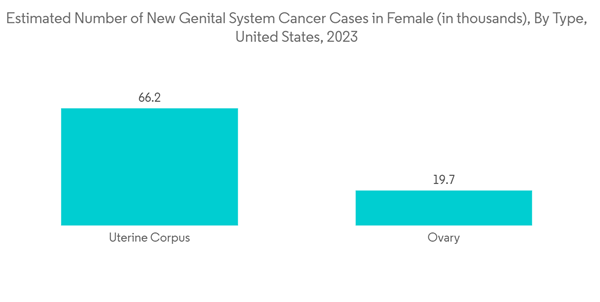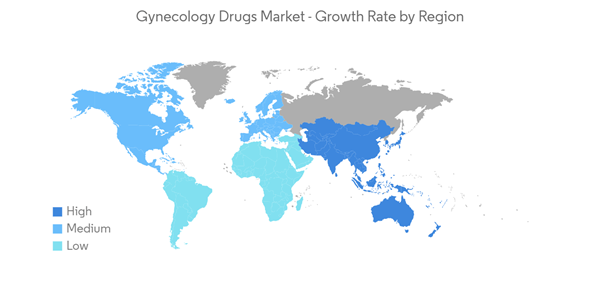Key Highlights
- The COVID-19 pandemic considerably impacted the management of patients with gynecologic diseases during the initial pandemic. For instance, according to a study published by SAGE Journals in August 2022, the management of gynecological cancers suffered during the pandemic, partly due to lockdowns and partly due to directing resources to manage COVID-19 patients. It was also stated that modification of gynecological cancer management during the pandemic was recommended. Therefore, such instances indicated that the market witnessed slow growth during the pandemic. However, with the easing of restrictions and lockdowns and declining cases of COVID-19, the market was expected to witness considerable growth over the forecast period.
- The major factors driving the growth of the studied market include the increasing burden of gynecological diseases and the rise in healthcare awareness along with the increasing aging female population.
- The rising incidence of various gynecological diseases is projected to continue in the future, which is likely to fuel the demand for efficient treatment, driving the global gynecological drugs market over the forecast period. According to an article published by Cureus in August 2022, a study was conducted in India, which showed that the prevalence of polycystic ovary syndrome (PCOS) was 6.8% among the study participants. The source also stated that polycystic ovary syndrome is a very common health problem among adolescents and young girls. Thus, the high burden of such diseases is expected to boost the market growth.
- Moreover, according to the data published by the National Cancer Institute in January 2022, the estimated number of new cervical cancer cases in 2022 was around 14,100 in the United States, which is around 0.7% up from previous years of all new cancer cases. Similarly, as per the report published by the American Cancer Society in January 2022, around 19,880 women were expected to receive a new diagnosis of ovarian cancer in 2022. Therefore, such a high prevalence of gynecology cancers is expected to fuel the demand for gynecology drugs, thereby propelling the market growth.
- Moreover, the rising developments by key market players are also enhancing the market growth. For instance, in May 2021, Myovant Sciences and Pfizer Inc. received approval from the United States Food and Drug Administration (USFDA) for MYFEMBREE, the first once-daily treatment for the management of heavy menstrual bleeding associated with uterine fibroids in premenopausal women, with a treatment duration of up to 24 months.
- However, the high cost and stringent regulatory framework that delays the approval of products are likely to impede market growth over the forecast period.
Gynecology Drugs Market Trends
Non-hormonal Therapy Segment is Expected to Witness High Growth Over the Forecast Period
- The non-hormonal therapy segment is expected to have a high growth rate over the forecast period. The lucrative growth of the segment can be attributed to the rise in the adoption of these products due to proven efficiency in the treatment, rapid advancements in new product development with reduced side effects, and the availability of a wide range of marketed products. Furthermore, the disadvantages of hormonal therapy, such as the risk of breast cancer and other complications associated with these products, are expected to foster the demand for non-hormonal products during the forecast period.
- Various studies are being conducted to measure the effectiveness and advantages of non-hormonal therapy. For instance, according to the study published by PubMed in March 2022, NLRP3/IL-1β is involved in the pathogenesis of endometriosis, and the NLRP3 inhibitor may be useful for suppressing ovarian endometriosis and improving the function of ovaries with endometriosis.
- In addition, increasing clinical trials for launching new non-hormonal therapy drugs for various symptoms are also surging the segment growth. For instance, in October 2021, Bayer commenced the Phase III clinical development program OASIS, which aims to evaluate the efficacy and safety of elinzanetant for the treatment of vasomotor symptoms during menopause.
- Therefore, increasing studies on non-hormonal therapy and clinical trials are expected to increase awareness of the application of non-hormonal therapy in treating gynecological cancers. Hence, significant segment growth is anticipated over the forecast period.
North America is Expected to Hold a Significant Share in the Gynecology Drugs Market
- North America is expected to hold a significant share of the gynecology drugs market over the forecast period. This dominance is mainly owing to rising incidences of breast cancer, menopausal disorders, polycystic ovary syndrome, and others due to busy lifestyles and the rise in stress among the women in the region.
- For instance, as per the report published by the Canadian Cancer Society in May 2022, it is estimated that around 1,450 Canadian women will be diagnosed with cervical cancer in 2022. Moreover, the availability of advanced healthcare infrastructure, an increase in government expenditure for women's healthcare awareness, and the senior women population, along with early product launches with enhanced quality in the region, are expected to contribute to the market growth over the forecast period.
- Key product launches, high concentration of market players or manufacturers' presence, acquisition and & partnerships among major players, and the high prevalence of gynecological cancers in the United States are some of the factors driving the growth of the gynecology drugs market in the region.
- For instance, as per the report published by the American Cancer Society in January 2022, breast cancer is the most common cancer in women in the United States, which is about 30.0% or 1 out of 3 of all new female cancers each year. Such high prevalence is anticipated to surge the demand for gynecology drugs, thereby propelling the market growth in the United States over the forecast period.
Gynecology Drugs Industry Overview
The gynecology drugs market is moderately competitive and consists of several major players. Some prominent players in the market are implementing various strategies, such as launching new products and making acquisitions to consolidate their market positions across the globe. The competitive landscape includes an analysis of a few international as well as local companies that hold the market shares and are well known, including Allergan Plc, Pfizer Inc, AbbVie Inc, TherapeuticsMD Inc, and Ferring Holding SA, among others.Additional Benefits:
- The market estimate (ME) sheet in Excel format
- 3 months of analyst support
This product will be delivered within 2 business days.
Table of Contents
Companies Mentioned (Partial List)
A selection of companies mentioned in this report includes, but is not limited to:
- Pfizer Inv
- AbbVie Inc
- TherapeuticsMD Inc
- Ferring Holding SA
- Lupin Pharmaceuticals Inc
- Johnson & Johnson
- Eli Lilly and Company
- Bayer AG










